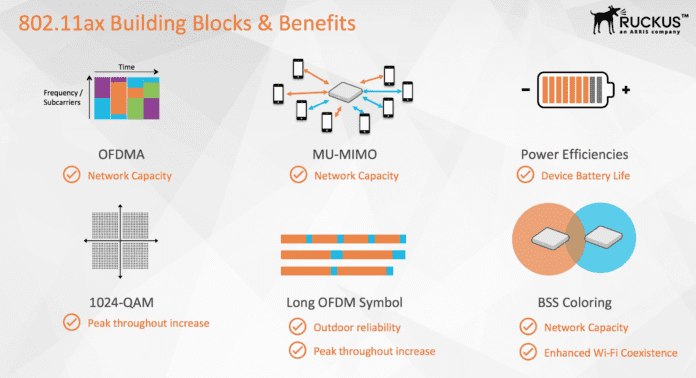Ruckus to ship 802.11ax access points this quarter
This week Ruckus, an Arris company, announced it plans to begin shipping access points that support the newest flavor of Wi-Fi, IEEE 802.11ax, this quarter. The Wi-Fi enhancement is designed to support ultra-dense deployment scenarios—think airports, stadiums, convention centers, etc…—and Ruckus’ AP is also tailored to support a wide range of internet of things (IoT) use cases.
Dennis Huang, director of product marketing at Ruckus, said 802.11ax is special. Past iterations of Wi-Fi followed a “contention-based resource allocation protocol. With ax we’ve moved much more toward deterministic Wi-FI.”
So what does that mean for an end-user? Huang pointed to trial activities in a stadium and in train stations in Japan. He said when there are around 1,000 access points and tens of thousands of clients, the Wi-Fi network is constantly being probed regardless of whether the probe is coming from someone who intends on connecting to the network. In the train station example, there are some people waiting in the station wanting to connect to Wi-Fi. But there are many more people walking in and out of the station simply probing the network but not connecting. “That scenario causes a lot of problems for Wi-Fi. Wi-Fi has to effectively respond to all these beacons and probe requests. This transient time management does a bunch of things behind the scenes but one of which is almost ignoring these transient clients that don’t have the intention of connecting to Wi-Fi so that availability can be provided to the devices that want to connect.”
From a technical perspective, 802.11ax operates in the 2.4 GHz and 5 GHz bands, has channel bandwidth up to 160 megahertz, has a peak PHY rate of 9.6 Gbps, OFDMA modulation and 1024 QAM.
To the IoT piece, Huang explained the access point is more than just Wi-Fi, it’s a “wireless access point for multiple PHY mediums. With the R730, we’ve actually embedded Zigbee and BLE radios inside.”
Looking ahead at pending FCC rule changes regarding shared use of the 3.5 GHz CBRS band, “We’ll be able to augment this product with a module that will further grow and enhance the product capabilities,” Huang said. “We see quite a long life for this access point as a whole. You need something in the enterprise for devices to connect to. Going forward there’s going to be all these IoT devices within an enterprise. We see that being most logically placed within the access point itself.”

